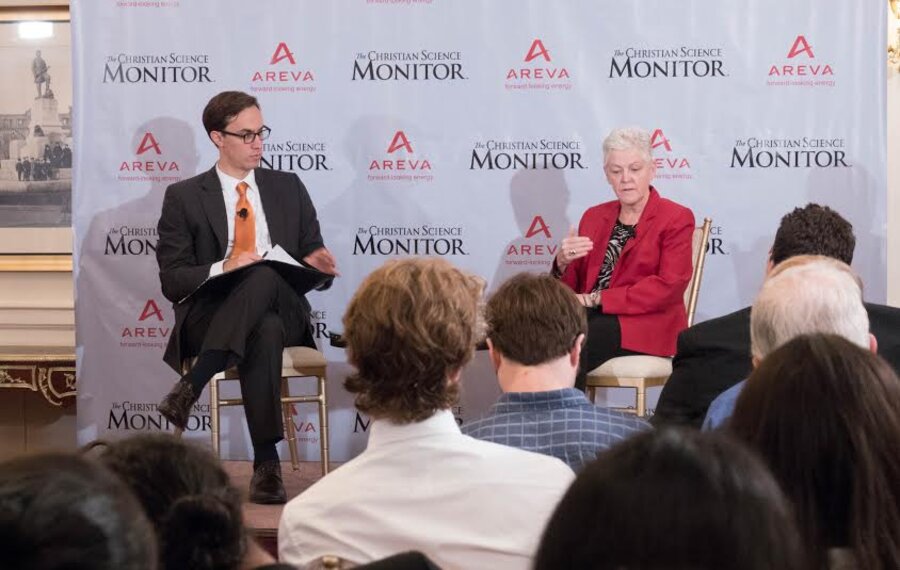EPA chief: New climate rules are safe from courts, Congress
Loading...
| Washington
The Obama administration is moving forward with a proposed plan to slash carbon emissions from US power plants despite attacks in courts and in Congress, the top US environmental regulator said Tuesday.
“The Clean Power Plan will absolutely be litigated,” US Environmental Protection Agency Administrator Gina McCarthy acknowledged Tuesday at a Monitor-hosted conversation in Washington, but she added that her agency is “still on track to produce that plan this summer.”
After the Supreme Court sent EPA’s rules on Mercury emissions back to the DC circuit last week, some observers wondered if that setback signaled rough waters ahead for the Obama administration’s boldest climate rule: the Clean Power Plan. Those proposed rules aim to cut US power plant emissions 30 percent below 2005 levels by 2030. At Tuesday’s event, Ms. McCarthy stressed that “last week’s ruling will not affect” the Clean Power Plan.
As negotiators work toward a global climate deal to cut emissions, the Clean Power Plan has emerged as the centerpiece of the US’s contribution to global climate efforts. President Obama says ambitious power plant cuts will spur other countries to offer equally bold emissions reductions, and that negotiators will be able to stitch all of those pledges into a global deal come December’s talks.
“If we don’t take strong action, we know we’re not going to get global action,” McCarthy says. The US is leading the way, she added, helping to ensure other major emitters across the globe make ambitious pledges.
Here’s a few other key points from McCarthy’s talk:
Three big ideas:
1. The economy and environment aren’t in conflict. The US has been cutting pollution and imposing new environmental regulations for decades, and its economy has grown – and that will continue as states begin to implement the climate rule’s emissions reductions, McCarthy said. In big emitters like China and India, she added, the idea that a clean environment is necessary for a strong economy is increasingly taking root, too. “They’re recognizing their air quality issues are part and parcel of a larger economic problem,” McCarthy said. Rapid industrialization in those countries has brought air pollution that threatens public health and the economy.
2. Momentum is building toward a climate deal. McCarthy expressed confidence that the US is posting a strong commitment toward the global climate deal taking shape through the UN. “Frankly I think the dynamics of the discussion are going in a much better direction than they ever have before,” McCarthy said. Those US pledges have helped get big emitters in the developing world – she mentioned China, India, and Brazil – to come to the table promising action of their own.
3. Energy is changing – with or without government action to slash emissions. Even without EPA regulations, utilities and businesses are shifting to cleaner-burning natural gas and zero-emissions wind and solar, McCarthy said. Natural gas is cheap enough to undercut coal, making it easy for the US to switch away from the emissions-heavy fossil fuel. Costs for solar and wind have also fallen precipitously in recent years, but as it stands now countries like China and Germany are leading the way in clean-energy manufacturing; as McCarthy said, in the US, “we have catch-up to do.”
Two notable quotes:
There’s nobody here that would have projected the technology innovation of the past two or three decades. The world has changed. Our kids don’t even know what the world looks like without cell phones and laptops … So for anybody to say that in 2030 I can’t project the exact ways for getting to the future that I think I need … and to use that as an excuse for inaction is pretty short-sighted, and is not looking at the history of this country. ... If you don’t actually move off of the starting gate when you’re in a marathon, you clearly will not win.”
We certainly know how to defend lawsuits … We’re actually very good at writing rules and defending them, and this [Clean Power Plan] will be no exception.”





